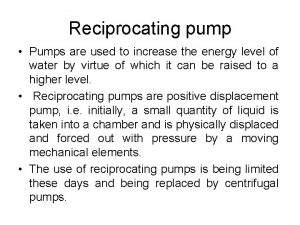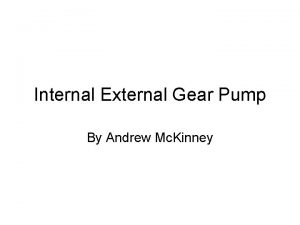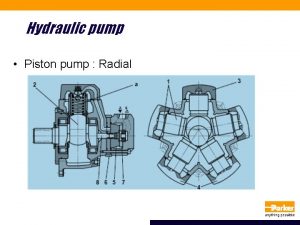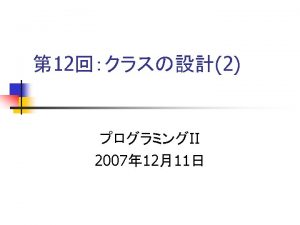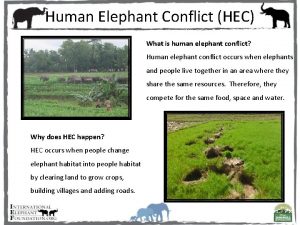Pump Aid and the Elephant Pump programme For





















- Slides: 21

Pump Aid and the Elephant Pump programme For MUS 1

Pump Aid and the Elephant Pump programme • • • Introducing Pump Aid The Elephant Pump Multiple Use Partnership Approach Challenges of Scaling Up Innovative Funding 2

History of Pump Aid • • Pilot scheme 100 Elephant Pumps starts 1998 Ministry approval & UK charity status Oct 1999 Nearly 4, 000 pumps and a million beneficiaries Pump Aid invited to assist 21 African countries Winners of St Andrews Environment Prize 2005 Malawi pilot launched by Vice-President 2005 Winners of World Bank Dev Marketplace 2006 3

Who are Pump Aid? • • A million Elephant Pump users Southern Based NGO with UK presence 132 staff in Zimbabwe and Malawi Professor Anthony Butterworth FRS Shungu Munyati (Nat Instit Health Res) Martha Rukuni ACA MBA Ian Thorpe (International Director) 4

How is an Elephant Pump built? Prior to pump installation a self-filtering well is dug up to 30 metres depth. The well is lined with bricks or concrete rings with the top section sealed and sand backfilled. 5

Features of the Elephant Pump • • • Low initial inclusive cost per pump and per beneficiary Five times cheaper than piston pumps (inclusive costs) Ease of maintenance by the pump owner at extremely low cost Sustainable and suitable for the most remote and poor areas High extraction rates of about one litre per second Far less energy used to lift a certain volume of water Suitable for children and the elderly, safe and enjoyable to use Adaptable design with a fallback extraction option (bucket) Yields high water quality, excludes sources of contamination Suitable for dry-season garden irrigation and when rains fail Built and maintained using only locally available materials 6

Features of the Elephant Pump • • • Beneficiaries contribute bricks, sand some labour Sense of ownership, due to involvement in construction Culturally sensitive design which can be repaired by women Extraction of water possible up to 30 metres depth Powered by renewable energy (hand /pedal power) Can be adapted to use solar or wind power if required Combined with self-cleaning hand dug well design Can easily be deepened should the water table fall Elephant pump is self cleaning, so cannot get clogged up No danger of children or animals falling in as fully enclosed Spare parts eg rope can be made by the beneficiaries 7

Examples of Agricultural Usage • • • Vegetable production Fruit trees and nurseries Livestock and fish Medicinal herbs Dry spell irrigation School nutrition gardens (bicycle) 8

Innovations in Sanitation • • “One bag toilet” - re-usable materials Culturally sensitive school toilet designs Urine diversion: fertiliser, pit life-span Avoiding deforestation - wet mud bricks, no need to boil water, tree planting • Hand-washing facilities, natural soap • Health and Hygiene Education • Maintenance and Sustainability 9

Impact on Livelihoods • • Income generation Time saved for productive activities Reduced days lost to illness Increased agric knowledge base Child headed households School attendance Home based care 10

A Partnership Approach Pump Aid works in partnership with: • A million Pump Users, Community Leaders • Other Non-Governmental Organisations (IDE CARE, OXFAM, CAFOD, PLAN, World Vision) • Training of NGOs and Social Enterprises (WISH) • District Councils (water/sanitation committees) • Governments (DFID, Ed, Health, Agric etc) • Schools and Clinics (200 school clusters) 11

The Tipping Point Over a million people now use the Elephant Pump every day Successful partnership programmes with well recognized organisations 12

Expansion Plans over five years • 32, 000 Elephant Pumps in Africa • School cluster, child-centred approach • 8 million with clean productive water, food security, 5 million trees planted, livestock • 4 million people with improved sanitation • Seeding and training in other countries • Propagation through training partnerships • Monitoring of SE and NGO trainees 13

Challenges • Monitoring impact (BRTI, PAL, WB etc) • Integration of Multiple Use (agric training, sanitation with hygiene education) • Multiple Use perceptions • Overcoming sense of threat • Working with Governments (Zim) • Sharing Experiences • Raising Funds for Expansion 14

Exponential Expansion Exponential expansion of a successful project brings its own challenges: Number of pumps being installed every month: 2005 (20), 2006 (50) 2007 (120) 2008 (250) Other NGOs being trained so that they can build their own Elephant Pumps eg World Vision Maintaining standards is a huge challenge 15

Sharing Experiences • • DFID UK/Harare (TLC) and British Embassies Int Centre for Water and Sanitation (IRC) Poverty Action Lab, St Andrews Prize Website, E-conferences, through partners Rural Water Supply Network, BRTI, NIHR HIDC, CFA, World Water Day events Field days (eg 12 NGO visits this month) MUS Group and other working groups 16

• World Bank Prize – Selected from 2, 500 water and sanitation projects from 254 countries 17

Innovative Funding 18

• • Launched 22 nd March Sold over 2 million bottles Over £ 250 K for Pump Aid A life in your hands Drop for Drop? One litre = 100, 000 litres ASDA and WAL*MART 19

20

director@pumpaid. org www. pumpaid. org 21
 A day with nandu
A day with nandu Facts about elephants
Facts about elephants What does the elephant represent in shooting an elephant
What does the elephant represent in shooting an elephant First aid merit badge first aid kit
First aid merit badge first aid kit St andrew medical centre
St andrew medical centre Types of reciprocating pump
Types of reciprocating pump Difference between internal and external gear pump
Difference between internal and external gear pump Screw pump vs gear pump
Screw pump vs gear pump The blind man and the elephant poem questions
The blind man and the elephant poem questions Iso 22301 utbildning
Iso 22301 utbildning Typiska novell drag
Typiska novell drag Nationell inriktning för artificiell intelligens
Nationell inriktning för artificiell intelligens Vad står k.r.å.k.a.n för
Vad står k.r.å.k.a.n för Shingelfrisyren
Shingelfrisyren En lathund för arbete med kontinuitetshantering
En lathund för arbete med kontinuitetshantering Adressändring ideell förening
Adressändring ideell förening Tidbok för yrkesförare
Tidbok för yrkesförare A gastrica
A gastrica Vad är densitet
Vad är densitet Datorkunskap för nybörjare
Datorkunskap för nybörjare Stig kerman
Stig kerman Hur skriver man en debattartikel
Hur skriver man en debattartikel





